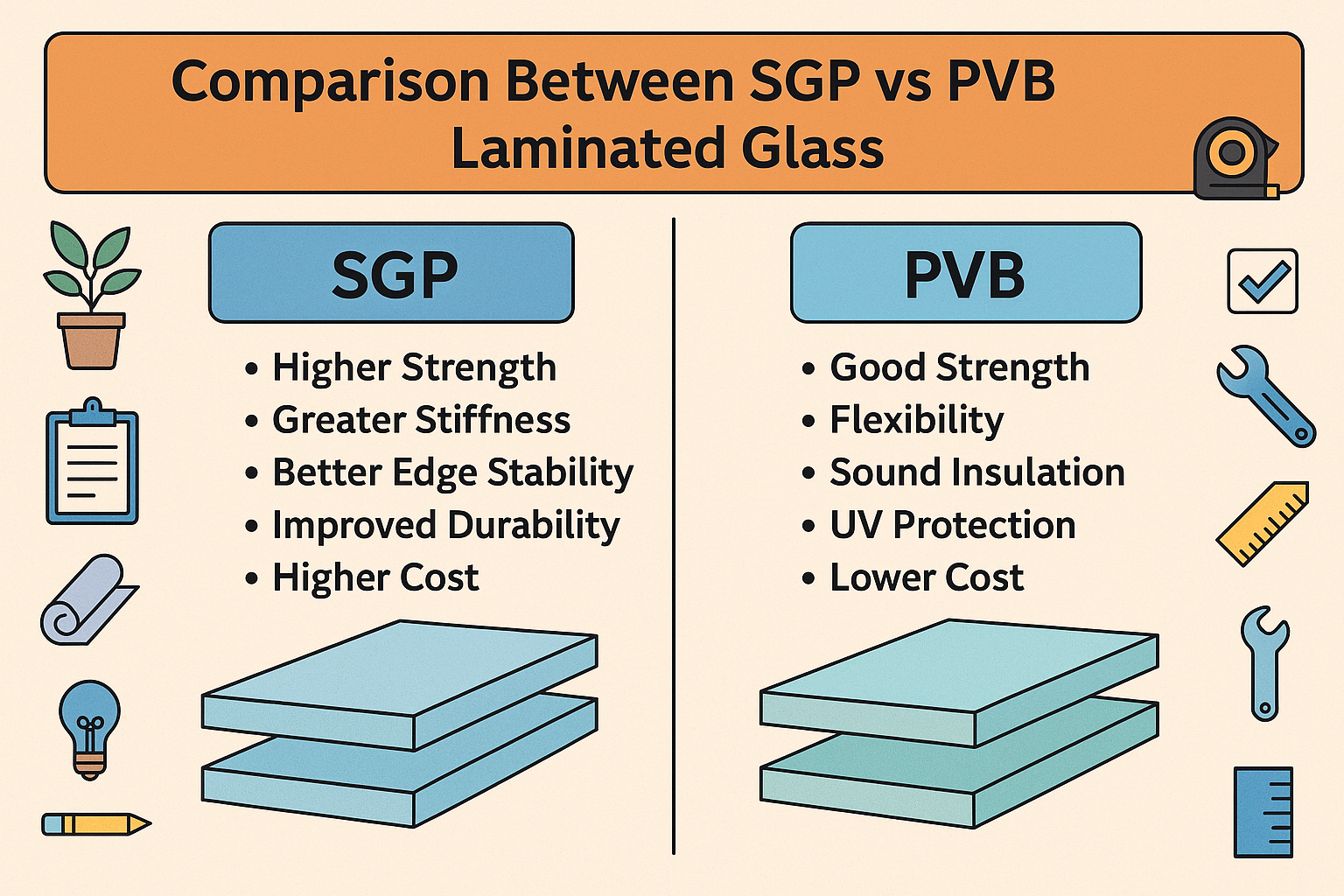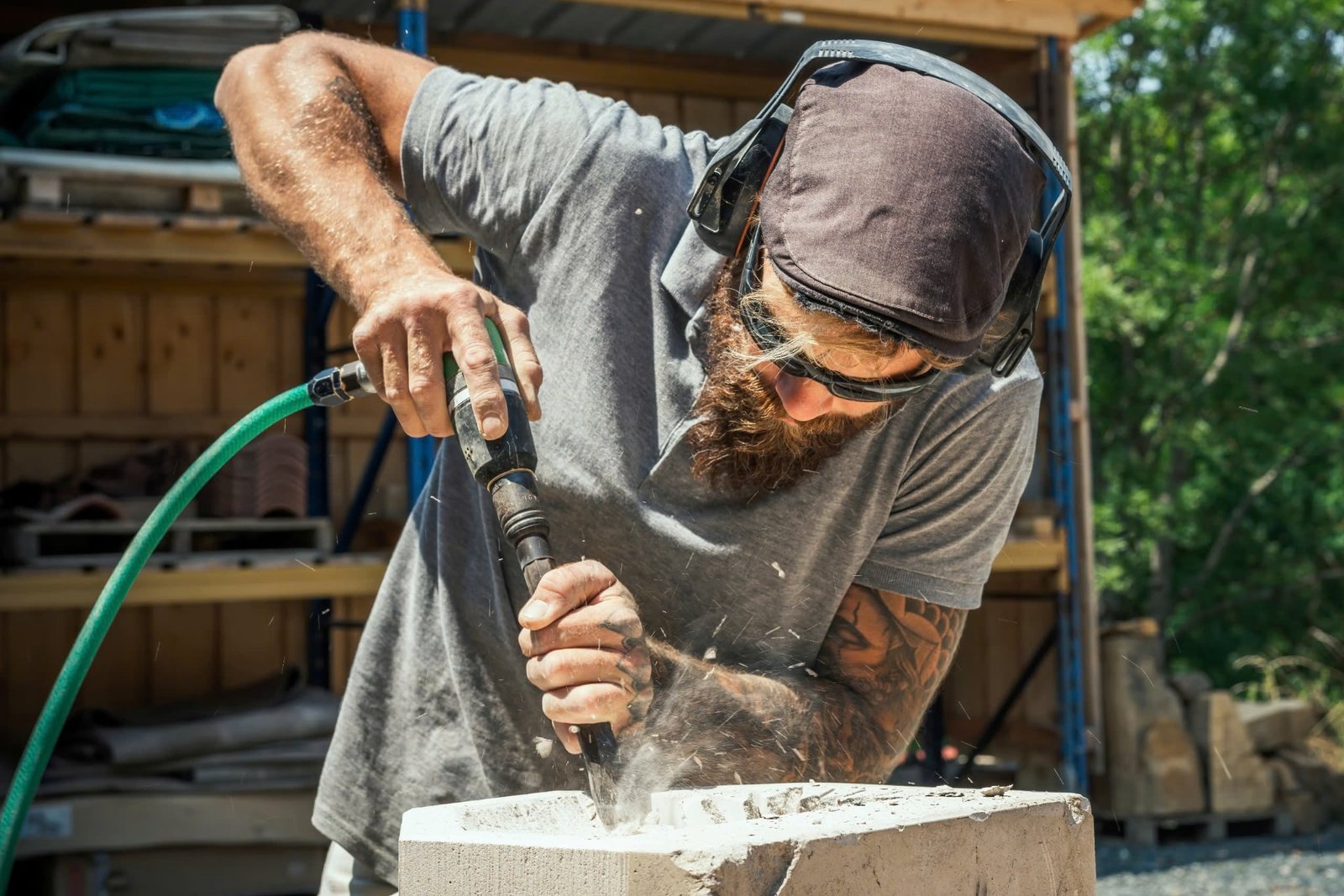
Among the various types of laminated glass, two options dominate the market PVB laminated glass and SGP laminated glass.
Laminated glass is a staple in modern architecture, prized for its safety, clarity, and durability. Among the various types of laminated glass, two options dominate the market PVB laminated glass and SGP laminated glass. While both materials share core similarities, such as impact resistance and sound insulation, they differ significantly in performance, structural integrity, and price. This article provides a comprehensive comparison between PVB and SGP laminated glass, detailing their unique characteristics, advantages, use cases, and which to choose depending on your project requirements.
What Is PVB Laminated Glass?
PVB laminated glass is composed of two or more glass layers bonded with a Polyvinyl Butyral (PVB) interlayer. This interlayer gives the glass its safety properties by holding shards together upon breakage, preventing injuries and maintaining the panel’s structural integrity. In addition to its safety benefits, PVB laminated glass also provides sound insulation, UV protection, and design flexibility.
PVB is flexible and adhesive, allowing it to bond well with glass surfaces. It’s also optically clear, which makes it suitable for architectural glass applications where transparency and appearance are key.
To learn more about its benefits and features, read PVB Laminated Glass: Everything You Need to Know.
What Is SGP Laminated Glass?
SGP, or SentryGlas Plus, is a more advanced interlayer made from ionoplast material. Developed by Kuraray, SGP offers superior strength and durability compared to PVB. It is five times stronger and up to 100 times stiffer than traditional PVB, making it suitable for structural glazing applications, high-load areas, and regions with extreme weather conditions.
SGP laminated glass maintains structural integrity even after breakage, with significantly less glass displacement. This makes it ideal for applications requiring enhanced post-breakage behavior, such as blast resistance, hurricane protection, and minimal deflection.
Material Strength and Performance Comparison
The biggest difference between SGP and PVB laminated glass lies in structural performance. SGP’s increased stiffness provides better load-bearing capacity and deflection control. This is crucial in overhead glazing, cantilevered glass balustrades, and glass fins, where bending under load can be dangerous.
PVB laminated glass is adequate for general applications like storefronts, interior partitions, and residential glazing. However, when structural performance and minimal deflection are essential, SGP is the preferred choice.
SGP’s superior tear resistance also ensures the glass stays in place longer after impact or breakage, offering extended security in high-risk areas.
Durability and Weather Resistance
Both PVB and SGP laminated glass provide strong weather resistance, but SGP outperforms in long-term durability. SGP’s ionoplast interlayer is less affected by moisture and edge exposure, reducing the risk of delamination over time.
In humid or coastal environments, SGP laminated glass maintains its clarity and adhesion better than PVB. For building envelopes, skylights, and façades that are continuously exposed to the elements, SGP provides a more robust and long-lasting solution.
PVB laminated glass can still be used outdoors but requires careful installation with protected edges, proper drainage, and compatible sealants to prevent moisture ingress and interlayer degradation. For care tips, refer to How is PVB Laminated Glass Made?.
Visual Clarity and Design Aesthetics
Both types of laminated glass offer good optical clarity, but SGP has a slightly higher light transmittance due to its lower haze levels. SGP laminated glass also provides a crisper appearance, which is preferred for high-end architectural projects requiring minimal visual distortion.
That said, PVB laminated glass offers more design flexibility. It supports a wide range of colored interlayers, decorative films, and digital prints. For interior design applications where aesthetics are paramount, PVB is often the go-to choice.
PVB laminated glass in design allows for creativity while still meeting safety codes. It’s common in partitions, doors, decorative panels, and railing infills in commercial interiors.
Sound Insulation Properties
In terms of acoustic performance, PVB laminated glass excels due to the dampening properties of its softer interlayer. PVB reduces airborne noise, making it ideal for buildings in noisy urban environments, hotels, schools, and residential towers.
SGP laminated glass, while stronger, does not absorb sound as effectively. Therefore, for projects prioritizing acoustic comfort over structural performance, PVB is a better choice.
Safety and Security Comparison
Both PVB and SGP laminated glass are considered safety glass and meet regulatory standards for impact resistance. However, SGP provides better post-breakage performance and holds broken glass in place more securely, even under significant loads.
For safety-critical applications like blast-resistant glazing, forced-entry-resistant windows, and hurricane impact zones, SGP laminated glass is the industry standard.
Still, for everyday use in commercial storefronts, homes, and low-rise buildings, PVB laminated glass offers reliable protection with a lower cost profile.
Installation Differences
PVB laminated glass installation is simpler and more widespread, with established techniques and readily available framing systems. However, it requires careful edge protection and moisture management to prevent long-term degradation.
SGP laminated glass installation may require reinforced supports due to its increased stiffness and weight. Installers also need to follow specific handling protocols to prevent surface damage or installation errors in structural systems.
Both types must be installed by qualified professionals familiar with glazing standards and best practices.
PVB Laminated Glass Maintenance vs. SGP
When it comes to maintenance, both materials are relatively low-maintenance with proper installation. Regular cleaning with non-abrasive cleaners and inspection for edge damage or delamination is advised.
However, PVB laminated glass requires more attention to edge conditions. If exposed to moisture over time, it is more prone to delamination than SGP. This can be mitigated with proper framing and sealants.
SGP laminated glass, on the other hand, is more resistant to environmental wear, making it ideal for less frequently serviced installations such as tall curtain walls and skylights.
Cost and Price Considerations
PVB laminated glass is significantly more affordable than SGP laminated glass. The price of PVB laminated glass typically ranges from $20 to $60 per square foot depending on thickness, treatments, and customization. It provides excellent value for residential and light commercial projects.
SGP laminated glass, being more advanced, can cost 1.5x to 2x more than PVB. Its price is justified by its enhanced structural and safety features, but it’s not always necessary for basic glazing applications.
Budget-conscious projects with moderate performance needs benefit most from PVB, while premium builds with strict performance specifications justify the investment in SGP.
Sourcing from Manufacturers
Reputable PVB laminated glass manufacturers and suppliers often also produce SGP laminated glass. Choose manufacturers that provide testing data, comply with international standards (such as ASTM or EN), and offer technical support for both materials.
Many projects benefit from working with a supplier who can offer guidance on material selection, based on location, design intent, and safety regulations.
When to Use Each Type
Use PVB laminated glass when:
- Cost efficiency is a priority
- Acoustic insulation is required
- Decorative options are needed
- The installation is in a controlled, indoor environment
- Light impact resistance is sufficient
Use SGP laminated glass when:
- High structural performance is needed
- Glass is used in cantilevered or unsupported designs
- It will be exposed to harsh outdoor environments
- There is a risk of extreme impact or blast
- Minimal deflection and clarity are critical
Conclusion: Choosing the Right Laminated Glass for Your Project
Both PVB and SGP laminated glass serve specific functions in modern design and construction. Understanding the differences between the two allows architects, contractors, and property owners to make informed decisions that balance aesthetics, safety, performance, and budget.
For most standard applications, PVB laminated glass offers an excellent combination of safety, clarity, and affordability. For demanding structural glazing and high-risk environments, SGP laminated glass delivers unmatched performance and durability.
To explore more about the benefits, care, and manufacturing of laminated glass, don’t forget to check:

